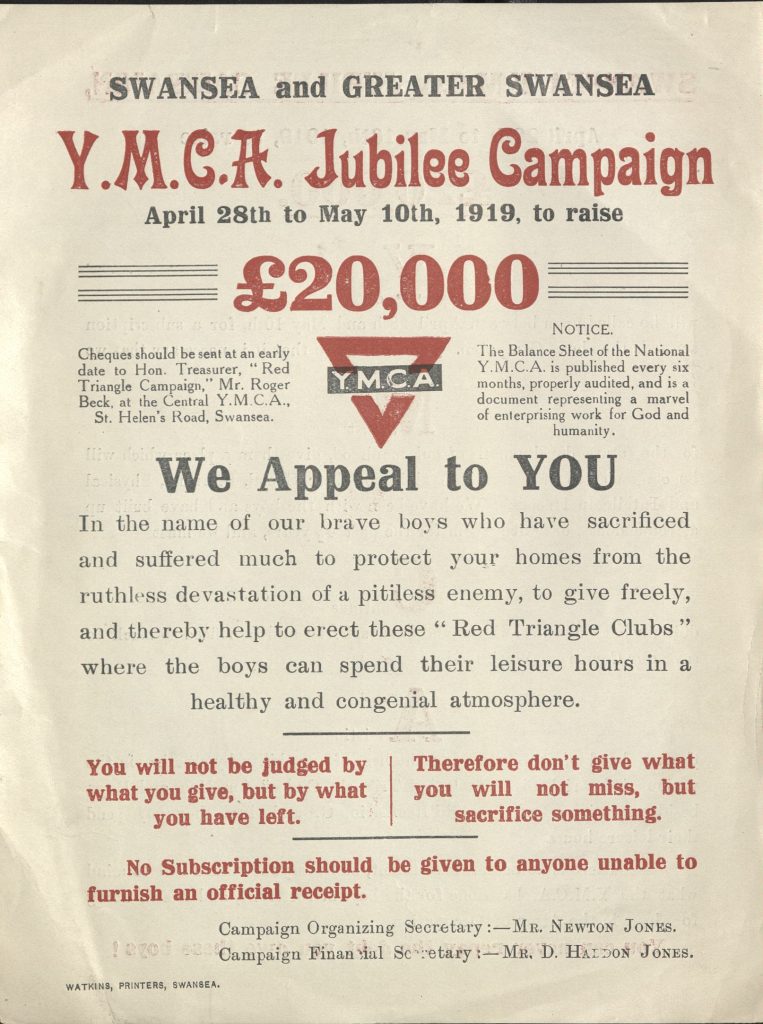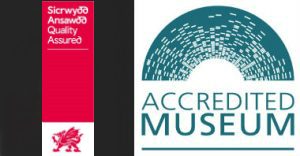West Glamorgan Archive Service reference SL WL 5/9/1

The poster is advertising a week long campaign to raise £20,000 to build a new support centre in Swansea for those veterans who served in WW1. The end of the Great War coincided with the 50th anniversary of YMCA Swansea.
On the right of the YMCA Red Triangle logo is a notice which seems rather odd. It states;
“The balance sheet of the National YMCA is published every six months, properly audited and is a document representing a marvel of enterprising work for God and humanity”.
The reason for the rather odd notice was that the appeal had already been effectively sabotaged and from a most unexpected quarter.
As well as providing YMCA huts at the front line, a considerable amount of work was being undertaken to support troops in Swansea.
50,000 meals had been served at St Andrews Hall (now Swansea Mosque), and where YMCA operated from May 1917 to March 1919. 80,000 sheets of writing paper given out to troops, sleeping accommodation provided to over 250 soldiers and sailors and
7,000 to 8000 free suppers provided. Food and accommodation provided also to 129 survivors of the Rewa, a hospital ship torpedoed in the Channel.
At an Executive Committee of YMCA Swansea on 1st October 1917 Mr. G. P. Cook-Davies stated that the number of Bit Badge Men in the town was about 900 (Bit Badge Men was a term for men who had done their bit but whom now were invalided out through illness or injury). After discussion it was decided to appoint a delegation to meet with Sir John Llewelyn (YMCA Swansea President) to consider what could be done. One idea considered was a hostel for soldiers and sailors and the need to investigate potential need.
In early 1919, the Red Cross notified the YMCA was that the building which had been turned into a hospital was expected to be handed back over on the 30th March
It was agreed to hold an open meeting and in the meantime that the ground floor be used as a club for past and present members of H.M Forces.
A Jubilee planning meeting was held on the 15th March. The minutes are difficult to read but discussion involves a possible extension to the hostel as well as a new build erected to the men who have fallen in the war, on the model of the Red Triangle huts.
At a special meeting in March 1919 the appeal was launched with a target of £20,000
Ward lists were produced to target 20,000 houses via 260 canvassers and the Rev. James would target markets and businesses.
Newspaper adverts were also to be placed. The appeal weeks would be the 28th April to 10th May. 300 posters and 500 window bills printed.
The appeal started well with the following promises:
Mr. Napier £200
Mr Cook £200
Richard Lewis £200
J. P Giles £100
S Palmer £52
W J Watkins £50
Total £802
The first indication of the appeal running into trouble comes in a minute dated 1st April, under a heading the Bishop of Swansea. The minute states:
“Mr Napier gave a brief report on the meeting of the National Council in London and stated that the Bishop of Swansea would be given an opportunity of substantiating or withdrawing his charge against the YMCA before a Commission appointed by the Council”.
A special meeting of the Executive Committee 16th April minute states
“The Chairman referred to the Bishop of Swansea attack on the YMCA in the Times Newspaper. In reference to the Bishops letter, Mr Highman gave exact information with regard to the Association building at Brecon and the success of that enterprise”.
The Cambrian newspaper reported on the allegations and subsequent inquiry by Lord Askwith on the 23rd May 1919. The central allegation by the Bishop was that the YMCA national body was competing with existing social organisations and that money subscribed for war purposes was now being used for peace schemes. It would appear that the criticism was triggered by something to do with Brecon YMCA but it is unclear what. The report by lord Askwith rejected the Bishops criticisms.
Although the Bishops letter to the Times had nothing to do with YMCA Swansea, the publicity effectively sabotaged the campaign. The appeal was pretty ambitious anyway, particularly when it was only eight years since a similar appeal had raised the £20,000 for the cost of the building on the Kingsway.
In June the Rev Newton Jones reported that Len Palmer had succeeded in collecting £131, the highest amount secured by a member. The campaign figure now standing at £4548 with another £100 promised from Messrs Baldwin’s. Another £250 was promised by the Butchers Association.
The minute’s state:
“Mr Napier moved thanks to Rev Newton Jones for his service as the campaign manager. The campaign had not reached its target. The attack upon the YMCA by the Bishop of Swansea and prevailing industrial unrest had doubtless influenced events.”
Mr Cook endorsed Mr Napier
“Campaign efforts had been largely controlled by unfortunate circumstances”
The appeal was finally closed with a total figure raised of £5692, well short of the £20,000 target.

